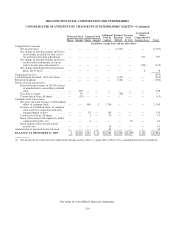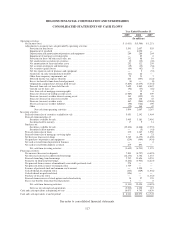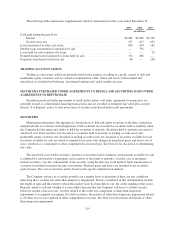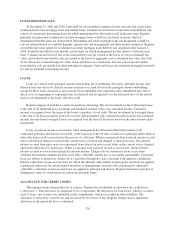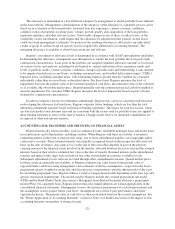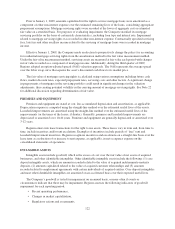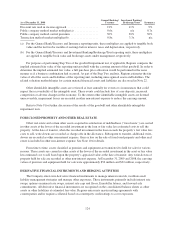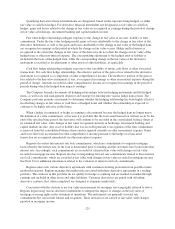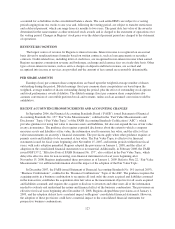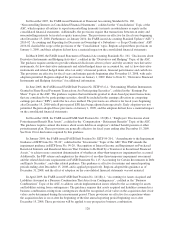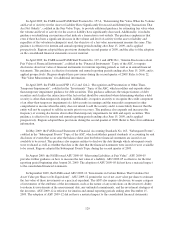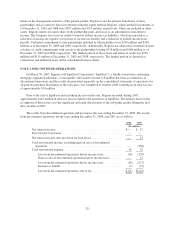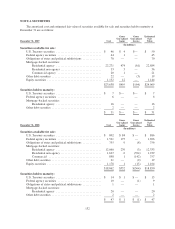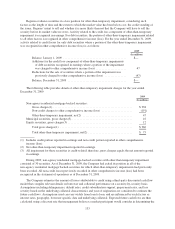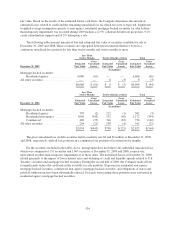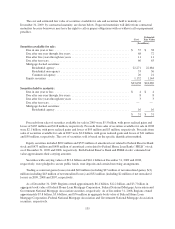Regions Bank 2009 Annual Report Download - page 140
Download and view the complete annual report
Please find page 140 of the 2009 Regions Bank annual report below. You can navigate through the pages in the report by either clicking on the pages listed below, or by using the keyword search tool below to find specific information within the annual report.INCOME TAXES
Regions and its subsidiaries file various federal and state income tax returns, including some returns that are
consolidated with subsidiaries. Regions accounts for the current and future tax effects of such returns using the
asset and liability method, recording deferred tax assets and liabilities and applying federal and state tax rates
currently in effect to its cumulative temporary differences. Temporary differences are differences between
financial statement carrying amounts and the corresponding tax bases of assets and liabilities.
From time to time, for certain business plans enacted by Regions, management bases the estimates of related
tax liabilities on its belief that future events will validate management’s current assumptions regarding the
ultimate outcome of tax-related exposures. If the tax effects of a transaction are significant, Regions’ practice is
to obtain the opinion of advisors that the tax effects of such a transaction should prevail if challenged. If the tax
benefits associated with a transaction are not more-likely-than-not of being sustained upon examination by
weighing the facts and circumstances at the reporting date, Regions records a liability for the recognized income
tax benefits associated with that transaction. The examination of Regions’ income tax returns or changes in tax
law may impact the tax benefits of these transactions. Regions recognizes accrued interest and penalties related
to unrecognized tax benefits as tax expense. Regions believes adequate provisions for income tax have been
recorded for all years open for examination.
Regions implemented authoritative accounting literature related to uncertain tax positions which required
that only benefits from tax positions that are more-likely-than-not of being sustained upon examination should be
recognized in the financial statements. As a result of the implementation, the Company recognized an
approximate $259 million increase in the liability for unrecognized tax benefits, which was accounted for as a
reduction to the January 1, 2007 balance of retained earnings.
Management evaluates the realization of deferred tax assets based on all positive and negative evidence
available at the balance sheet date. Realization of deferred tax assets is based on management’s judgments
regarding future events including future projected income, implementation of plans to maximize realization of
deferred tax assets, taxable income within the carryback period and reversal of taxable temporary differences.
TREASURY STOCK
The purchase of the Company’s common stock is recorded at cost. At the date of retirement or subsequent
reissuance, treasury stock is reduced by the cost of such stock with differences recorded in additional paid-in
capital or retained earnings, as applicable.
SHARE-BASED PAYMENTS
Compensation cost for share-based payments is measured based on the fair value of the award, which most
commonly includes restricted stock (i.e., unvested common stock) and stock options, at the grant date and is
recognized in the consolidated financial statements on a straight-line basis over the requisite service period for
service-based awards. The fair value of restricted stock or restricted stock units is determined based on the
closing price of Regions’ common stock on the date of grant. The fair value of stock options where vesting is
based on service is estimated at the date of grant using a Black-Scholes option pricing model and related
assumptions. Expected volatility considers implied volatility from traded options on the Company’s stock and,
primarily, historical volatility of the Company’s stock. Regions considers historical data to estimate future option
exercise behavior, which is used to derive an option’s expected term. The expected term represents the period of
time that options are expected to be outstanding from the grant date. Historical data is also used to estimate future
employee attrition, which is used to calculate an expected forfeiture rate. Groups of employees that have similar
historical exercise behavior are reviewed and considered for valuation purposes. The risk-free rate is based on the
U.S. Treasury yield curve in effect at the time of grant and the weighted-average expected life of the grant.
Beginning in 2009, Regions issued restricted stock units payable solely in cash (“cash-settled RSUs”), which are
126


